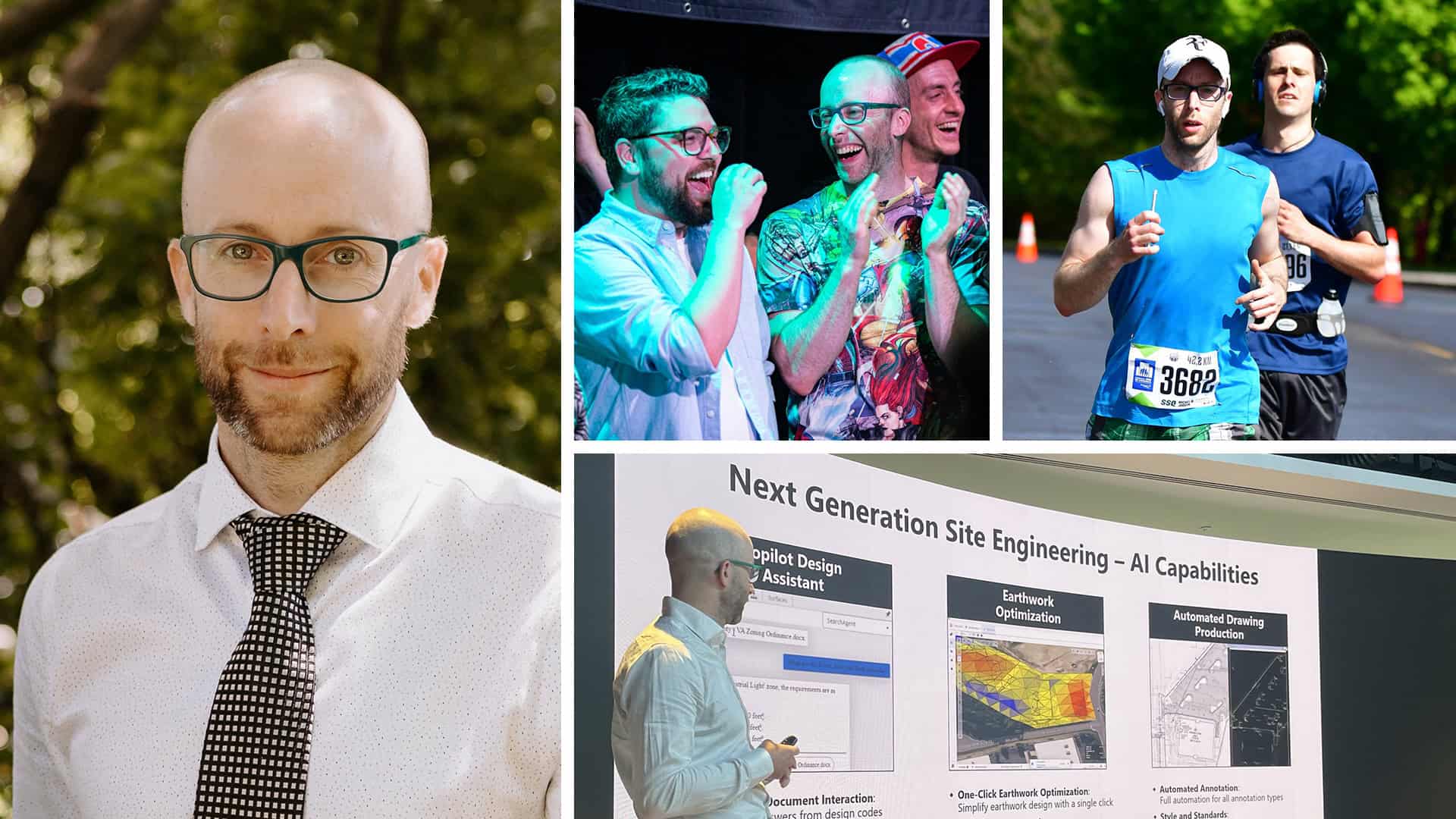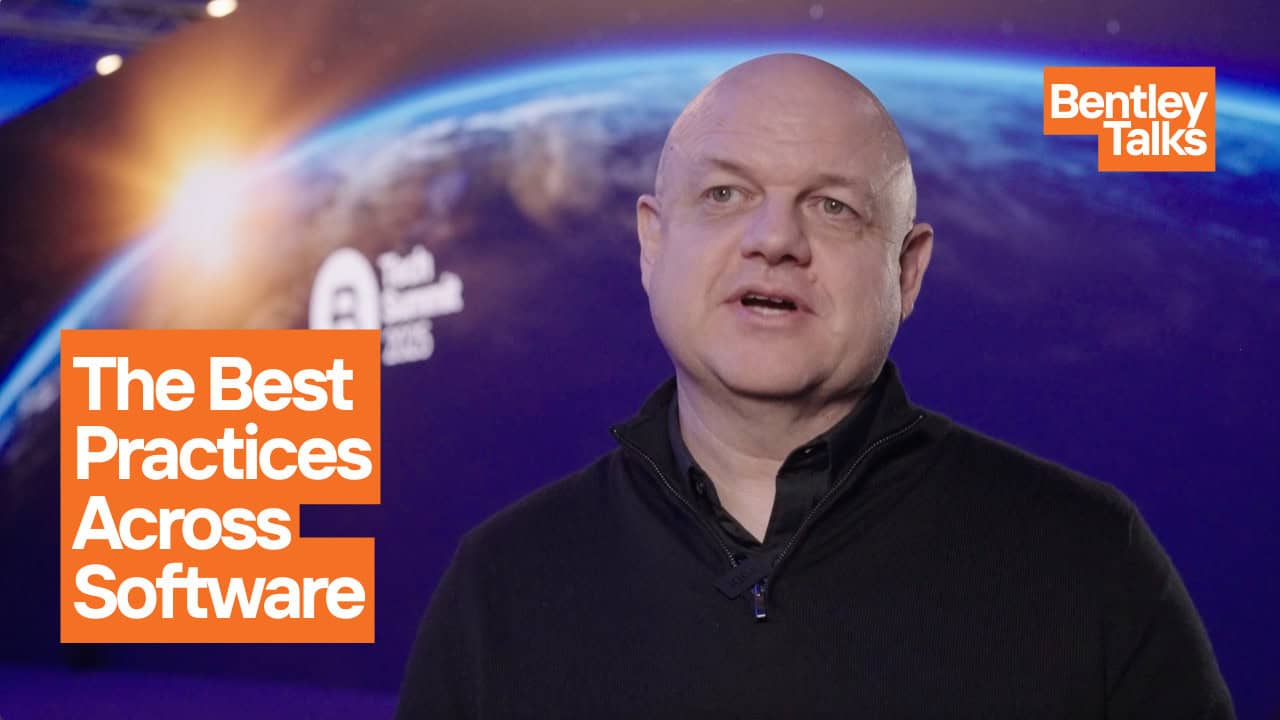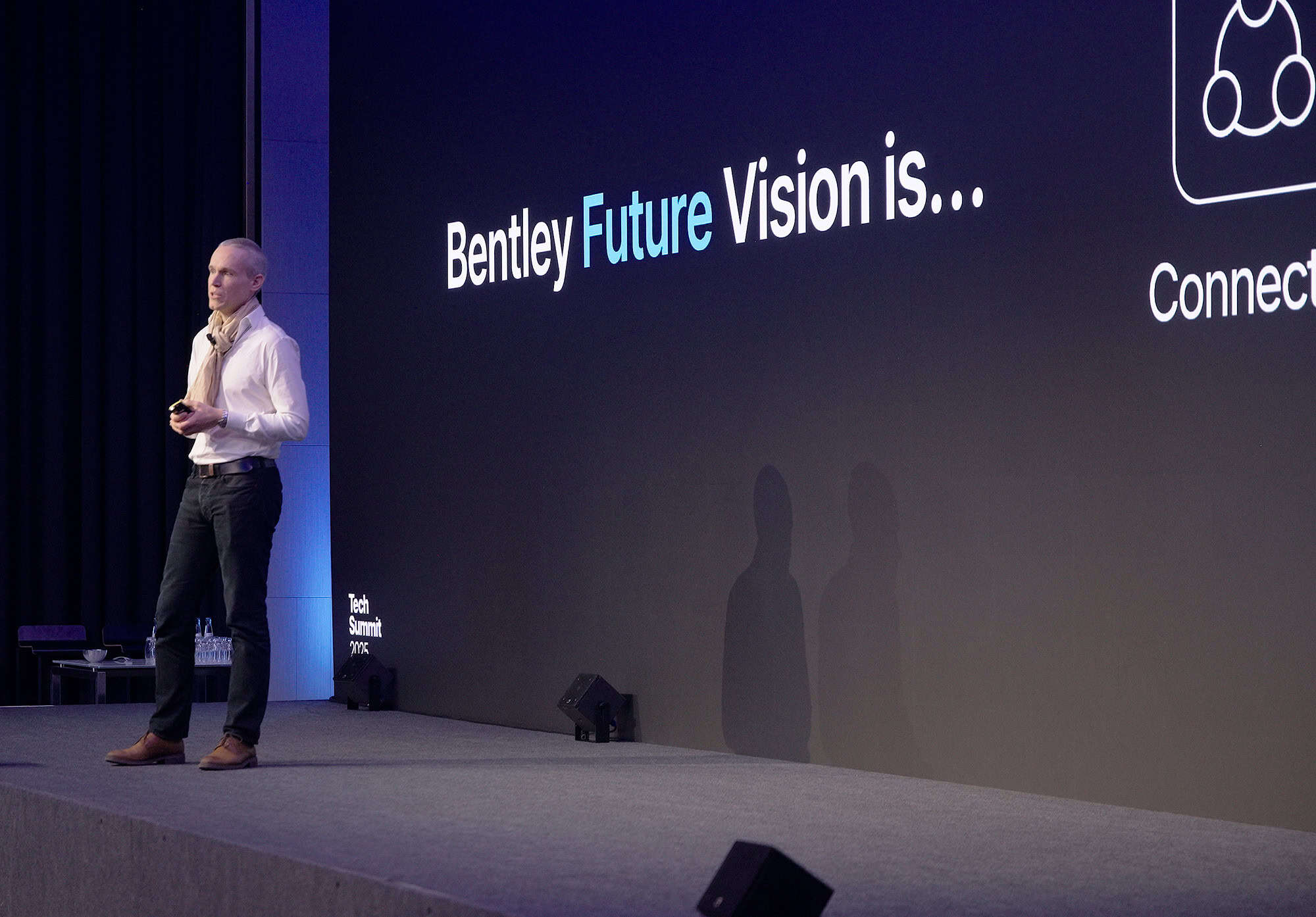Karl-Alexandre Jahjah is nearly impossible to catch off guard – or to outrun. He, where quick thinking means survival and glory. He also runs marathons, including one less than a year after rupturing his Achilles tendon. That mindset – face a challenge, get to work, push through – underlies Jahjah’s success as Bentley Systems’ director of applied AI, where he leads the team building the next generation of AI-powered infrastructure tools.
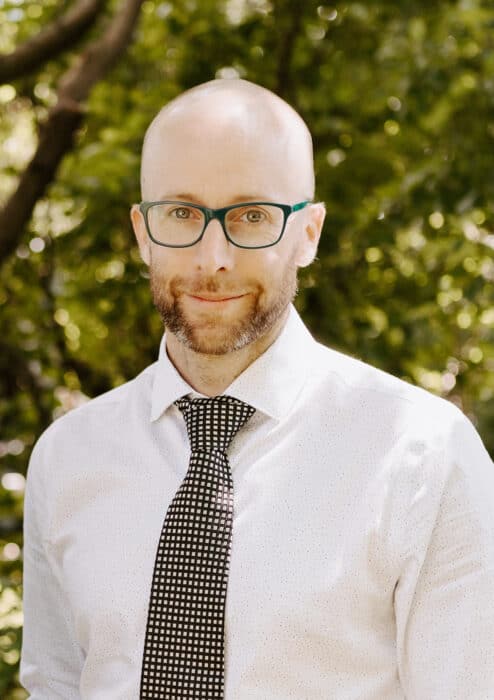 Karl-Alexandre Jahjah, director of applied AI at Bentley Systems
Karl-Alexandre Jahjah, director of applied AI at Bentley SystemsInside the company, he has built a reputation as someone who can transform complex engineering problems into working products. He’s also known for his collegial workplace style, a trait polished by his improv background. “Even the fiercest-seeming improv battles are actually collaborative,” he says. “The magic always comes when you build off each other’s best ideas.” It’s the same spirit he brings to his current flagship project: OpenSite+, which was released to testers at Bentley’s Year in Infrastructure event in 2024 and will be generally available later this year after a limited release in late June.
From an early age, Jahjah was one to watch. On his first day of kindergarten, he walked over to the reading corner, chose a book, and began reading aloud to the other children. Within a week, he was bumped up a grade. “After that, I was always the youngest in my class,” he says. “They offered to skip me ahead again in high school, but I was already visibly younger than everyone else and it wasn’t helping me socially.”
What did help socially was Jahjah’s discovery of improv, which is a cultural phenomenon in Quebec. As a self-described nerd, putting his wits to work on the stage was a revelation. “I realized I could make people laugh with me, instead of at me,” he says.
A Mind in Motion
Sports scratched the same itch – competition, pressure, the thrill of pushing limits – even if it didn’t come as easily as academic work. At Cégep, Quebec’s pre-university college, Jahjah joined the badminton and volleyball teams, often training for over 30 hours a week. “I wasn’t the tallest or the strongest, but I pushed myself to beat everyone – run faster, play harder,” he says. “I wanted to see how good I could get if I really tried.”
By university, he’d fought his way into Quebec’s prestigious top-tier improv leagues, notable for their competitive, fast-paced team formats. Later, Jahjah co-founded Le Punch Club, an improv show with the swagger of a rap battle and the format of a sports tournament. Over 13 years and more than 300 performances, it has gained a cult following in Quebec.
Jahjah approaches life and work the way he approaches improv: with curiosity, commitment, and a readiness to build from whatever comes his way.
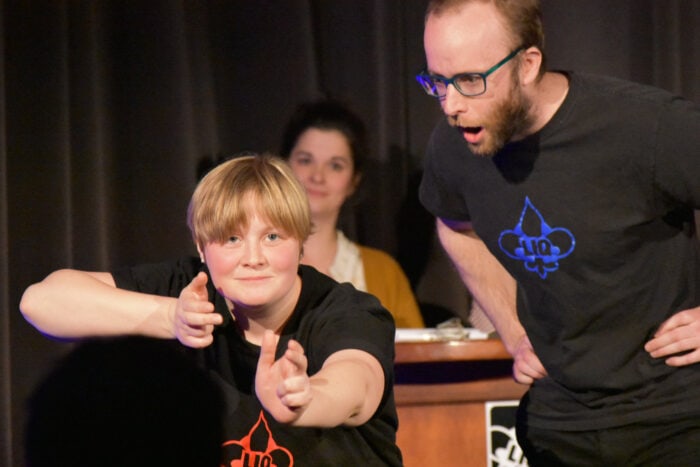 Jahjah’s improv background helps shape his unique approach to teamwork and passion for using AI to transform the future of infrastructure.
Jahjah’s improv background helps shape his unique approach to teamwork and passion for using AI to transform the future of infrastructure.Hitting the Pavement
For someone with so much drive, it is ironic that he has opted not to … drive. Jahjah has a license but has never owned a car. He runs or cycles almost everywhere, whether commuting through Quebec’s snowy winters or taking his kids to swimming lessons or soccer practice. “For me, time spent driving is 100% lost,” he says. “If I’m moving, I want it to count.” During the pandemic, for want of a challenge, he began mapping out and running every street in his Quebec City, sometimes covering marathon distances just to explore unfamiliar neighborhoods.
In 2023, on the eve of his 39th birthday, Jahjah ruptured his Achilles tendon during a tennis lesson. Within an hour, he was online ordering dumbbells – already planning how to stay active during rehab. After surgery, he logged so many miles in his orthopedic boot that he nearly wore through it. Shaving two months off his expected six-month recovery time, he later ran a full marathon, finishing just seven minutes behind his pre-injury personal best of 3 hours, 7 minutes.
 “For me, time spent driving is 100% lost. If I’m moving, I want it to count,” said Jahjah who has his sights set on qualifying for the Boston Marathon.
“For me, time spent driving is 100% lost. If I’m moving, I want it to count,” said Jahjah who has his sights set on qualifying for the Boston Marathon.‘There’s No Scoreboard’
At Laval University, Jahjah studied physics engineering, specializing in optics at the school’s world-renowned institute. A professor who had collaborated with Nobel laureates encouraged him to apply for a national science Ph.D. scholarship. Jahjah won – and later learned his application ranked second in the entire country.
He spent several years researching infrared fiber lasers, but he ultimately realized academia didn’t match his drive to compete. “There’s no scoreboard,” he says. “No way to know if you’re doing better than someone else. In industry, the feedback is immediate – and that’s what I wanted.”
He found it at a small infrared camera company called Telops, where he landed his first role as a systems engineer. “It was a perfect fit,” he says. “I spent five fun years overseeing the optical, mechanical, electrical, and software requirements of the cameras we were building.” Soon he was craving a new career challenge.
It came in 2017, around the beginning of the modern AI boom, when a company called AI Worx visited Telops to give a presentation on the potential of AI in engineering. AI had intrigued Jahjah since high school, when his uncle, a professor of AI in the U.S., would tell him about it, even mailing him an AI textbook that Jahjah had read cover to cover.
“I told AI Worx, ‘I’ve never done AI, but I learn fast. Give me a shot.’” The company knew of Jahjah’s reputation, so they gave him that shot. He would divide his time between AI projects and engineering consultancy. About a year after Jahjah joined the company, AI Worx was snapped up by Bentley Systems, which was looking to bring the power of AI into infrastructure design.
His First Bentley Project
Jahjah was hired as an Applied AI scientist, and his first major Bentley project came straight from the top. “Sitting down with Keith Bentley was a defining moment for me,” Jahjah says. Then the company’s chief technology officer, Keith Bentley talked about process and instrumentation diagrams (P&IDs) – technical drawings that show how industrial systems are connected, including pipes, valves, and equipment. “Many of our users had thousands of them in paper format – some even hand-drawn – or just vanilla CAD drawings, with no way to query them or extract meaning.”
Jahjah volunteered to attack the problem. Over two years, he assembled and managed a team to create the system from scratch: sourcing data, training a proof-of-concept AI model, onboarding pilot users. The result was a machine learning tool that turns legacy diagrams into searchable, data-rich digital twins. The digital models enable engineers to instantly locate and understand components of a project without having to dig through stacks of paper.
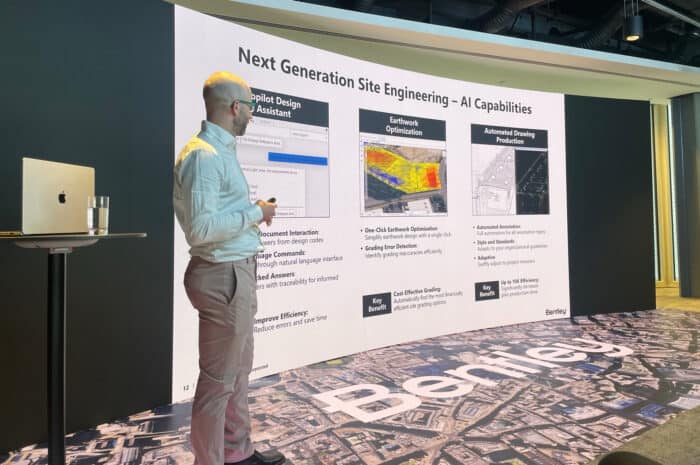 Karl-Alexandre Jahjah discusses AI capabilities during a session at Bentley’s London office.
Karl-Alexandre Jahjah discusses AI capabilities during a session at Bentley’s London office.Jahjah’s current project, OpenSite+, is a next-generation tool for designing building sites and land developments. The tool uses AI to accelerate everything from design and layout planning to compliance checking and drawing production. A key feature is known as generative optimization: feed the system your requirements and constraints, and it instantly generates a wide range of layout options, optimizing for factors like drainage and earthwork costs.
OpenSite+ also features an AI copilot, which is based on a large language model (LLM) and trained to handle the kind of documents that engineers dread, like a 500-page PDF of zoning regulations. Upload the document, and the copilot can answer questions and even flag compliance issues with the site design, citing the exact clauses – and underlying causes – of concern. Users can also instruct the copilot to act on the design. For example, changing the car-parking angle to 60 degrees. “Site design becomes a collaboration between the human and the AI, with the human firmly in charge,” Jahjah says.
After the designs are completed, OpenSite+ auto-generates or amends the final 2D drawings – neatly labeled, dimensioned, and produced in minutes instead of hours or days. “It’s not the flashiest application of AI, but it saves our users a huge amount of manual work, and they love that.”
Getting It Right on AI
In a world of massive AI hype, flashiness is not Jahjah’s goal. “People are still skeptical about what AI can actually deliver,” he says. “That’s why it matters that we get it right – and help users build confidence.”
Next up, Jahjah is focused on coordinating the integration of AI into Bentley’s other heavy hitters – ProjectWise, an infrastructure collaboration platform, and SYNCHRO, Bentley’s 4D construction planning tool. “Some customers have millions of documents in ProjectWise, in many different formats, and it’s really hard to extract insights from all that information,” says Jahjah. LLMs will unlock that buried value, making years of archived data searchable, usable, and actionable across infrastructure projects.
While his focus at Bentley remains squarely on AI’s future, Jahjah still finds time for high-stakes challenges. His personal goal this year: breaking the three-hour marathon barrier and qualifying for the Boston Marathon, an itch that every serious marathoner seeks to scratch. This May, he took part in the Marathon de Drummondville in Quebec, despite feeling unwell in the days leading up to the race. Still, he felt strong on the day – clocking the first half in 1:29 and holding a pace that would have earned him both a personal best and a Boston spot. But by kilometer 32, he was running alone, thirsty and disoriented. “There weren’t that many water stations,” he says.
At the 41-kilometer mark – just 1 kilometer from the finish, and in 9th place – Jahjah collapsed from severe dehydration. “I didn’t know what the date was; my phone looked like a foreign object. It was a fascinating experience.” Paramedics helped him recover, and within hours his clarity returned. He remains philosophical: “Lesson learned. I’ll just need to do it one more time – drinking more – to reach my goal.”
Sean O’Neill is a seasoned editor, journalist, and science communicator. He spent 14 years at New Scientist and served as the magazine’s People Editor. Sean has written for Google DeepMind, served as communications lead at the Cambridge Centre for AI in Medicine at the University of Cambridge, and worked as a Science Writer for The Alan Turing Institute in London. You can also find his byline on AI stories and profiles on the Bentley blog.
